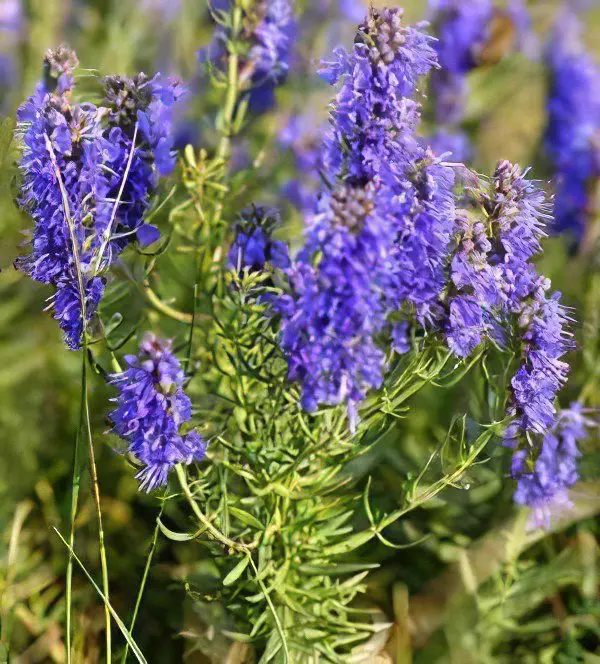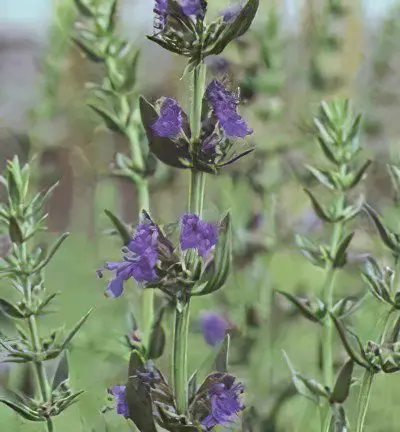Contents
Useful properties, cultivation, recipes and contraindications for the use of hyssop
Botanical characteristics of common hyssop

This tall subshrub with woody roots belongs to the Lamiaceae family. On long, thin and branched stems, there are opposite leaves, which are small on top, and larger in size closer to the bottom. Small flowers of the plant are arranged in 3-7 pieces in the axils of the leaves. The flowers form an inflorescence spike at the top of the stem. Hyssop flowers come in a variety of colors, ranging from blue to purple. The seeds of the plant are brown and very small. They ripen for a very long time, this may take several months. The flowering of the plant begins in June and lasts all summer and even mid-autumn. The plant has a very strong but pleasant aroma.
In the wild, hyssop can be seen in the Crimea, the Caucasus, Kazakhstan and the Altai mountains. It is also grown in Ukraine and the Caucasus.
Growing hyssop vulgaris
Hyssop is propagated by seeds, dividing the bush and seedlings. Seedlings are grown in nurseries for about two months. Before planting the plant, the soil must be fertilized with mineral fertilizers. Seeds are sown either before winter or early spring. After 1 or 2 weeks shoots appear.
In order for the plants to be strong and suitable for planting, they need to be thinned out. Hyssop is very good for transplanting. When planting a plant, it is necessary to observe a distance between rows of 30–35 cm. The crops should be watered regularly with cool water, it is also necessary to loosen and weed in the rows. Every spring you need to make a full fertilizer. Summer is the time to cut the greenery of the plant. As it grows, about two more cuts are made per season.
Hyssop loves fertile and light soil; it grows in one place for 5 years. The main thing is to create favorable conditions for him to grow well.
Essential oil of hyssop
Essential oil is extracted from the leaves of hyssop by steam distillation. This oil is yellow-green in color, light and fluid, with a tart sweet aroma. The oil improves a person’s well-being, improves mood and increases stamina. It is used for angina. Due to the property of the oil to reduce bronchial spasms, it is used for asthma.
Hyssop oil is a good remedy for the treatment of rheumatism. It has antiseptic and antispasmodic properties.
Hyssop essential oil calms the nervous system, so it is recommended for nervous exhaustion, depression and stress. And also this oil helps with allergic diseases of any kind. Who has low blood pressure, hyssop oil helps to increase it.
Rubbing with hyssop oil. For this procedure, take 10 drops of hyssop oil and mix them with 20 ml of ordinary vegetable oil, you can add eucalyptus or thyme. This oil is used for rubbing with a severe cold or bronchitis.
Bath with hyssop oil. It is necessary to take 5-10 drops of plant oil and add them to the bath. They take such baths for nervous exhaustion, stress and depression. You need to stay in the bath for up to 7 minutes, no more.
Oil for external use. This oil can be applied to wounds, acne, eczema, bruises, warts and even bruises.
Hyssop oil should not be used by pregnant women, people with epilepsy and frequent muscle cramps.
Useful properties of hyssop

The beneficial properties of hyssop have long been widely used in folk medicine. The leaves of the plant contain omanic acid, tannins, ursolic acid. Hyssop flowers contain diosmin and hyssopin.
Hyssop is used as an expectorant for colds and diseases of the upper respiratory tract. This plant contains substances that have an anti-inflammatory effect, promote the secretion of mucus, accelerate the diuretic process in the body and remove inflammation in the gastrointestinal tract. Hyssop is an ingredient in many herbal mixtures.
Preparations from hyssop have lactogenic and antibacterial properties. Hyssop normalizes digestion, relieves inflammation of the urinary tract. This plant relieves excessive sweating. Hyssop is also an excellent remedy for removing worms from the body.
The use of hyssop ordinary
In folk medicine, hyssop is used as an infusion, decoction, oil and tea. Leaves and flowering tops of the plant are used to prepare preparations.
Hyssop has analgesic properties. Hyssop infusion is used for sore throats as a gargle. Compresses are made from the infusion, which must be applied to the site of injury or to a wound that does not heal for a long time. Drinks from hyssop are useful for the elderly, as they normalize the work of the stomach and stimulate appetite. A decoction of the plant helps with conjunctivitis. Infusion from the inflorescences of the plant is used as an anthelmintic and astringent. Hyssop can also be used externally – for example, with stomatitis or bad breath. Diuretic teas are brewed from hyssop. With an infusion of hyssop, lotions are made that contribute to the resorption of strong hematomas.
Hyssop recipes
Hyssop infusion for asthma. Take one handful of chopped plant grass and pour 1 liter of boiling water over it. Pour everything into a thermos and close the lid tightly after 5 minutes. After an hour, you need to strain the finished infusion and pour it into a thermos again. 20 minutes before meals, use the prepared infusion hot, 1 glass a day. The course of treatment is 1 month.
A mixture of hyssop for suffocation. To prepare it, you need to take dry hyssop leaves and grind them into powder. Take 100 grams of powder and mix them with 100 grams of any honey. This mixture is taken before meals three times a day, 1 teaspoon with water. The same mixture helps with tinnitus and shortness of breath.
A decoction of hyssop from sweating (including menopause). Take 1 teaspoon of hyssop herb and pour 200 ml of boiling water over it. Leave for 2 hours to brew. After straining the decoction, it can be used 3 times a day, 100 ml before meals. This decoction will improve digestion and restore the function of the gastrointestinal tract.
Contraindications to the use of hyssop
Hyssop preparations are contraindicated in pregnant women and people with kidney disease. If, due to the intake of hyssop, signs of diarrhea appear, then it is immediately necessary to stop taking it. Nursing mothers should absolutely not use preparations from hyssop, since it contains substances that, in extremely rare cases, can reduce lactation, and in some cases even contribute to its cessation.









